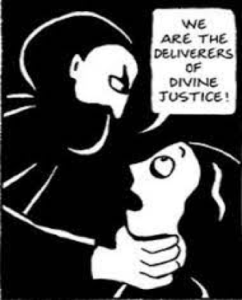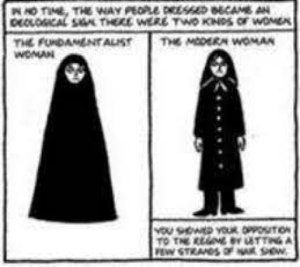The Story of a Childhood in a Theocracy:
Persepolis, and Justice
By Yasemin Kuyucaklı Karaöz

Persepolis: The Story of a Childhood (2003) is the consolidated English translation of Marjane Satrapi’s two graphic novels – the first, The Story of a Childhood, and the second, The Story of a Return- originally published in French. The novel can be considered an auto-biography as the story of Satrapi’s childhood in Iran is entwined with the political history of her country. Persepolis is set in the tumultuous atmosphere of Tehran during the Islamic Revolution in and after 1979. The novel- written from the perspective of a child- while offering the reader a wry and sympathetic narrative, highlights the urgent need for a democratic society in which individuals can enjoy their personal, religious and political freedoms and rights simultaneously.
Satrapi, through the use of strip graphics, sets the readers on an arduous journey in a country where inalienable human rights- i.e. right to life and education- are violated brutally; being forced to wear a veil and not allowed to leave the country, the individual freedoms of women such as freedom of movement, thought, and religion are restricted severely. Young Marjane’s naïve and humorous account of the political climate further delineates the vehemence of the situation. Ministry of education’s decree: ¨the educational system and what is written in school books are decadent, that’s why we’re closing universities. Better to have no students than to educate future imperialists¨ (p.73) shatters her innocent hope to become like Madam Curie almost permanently. Sadly, Marjane is forced to grow up prematurely when she eventually realizes what ¨that old tale about being on a trip (p.67)¨means in the political environment of her country when her beloved uncle Anouche is executed, never to come back from his trip. Persepolis is replete with many a representation of state oppression that highlight the miscarriage of justice in the country. Many acquaintances of Satrapi family and those others regarded as threats for the system are unjustly executed, assassinated, tortured, or imprisoned. Worst of all, in the absence of moral values, a human tragedy is acted out relentlessly when state leaders, not to relinquish power, opt to preserve the state of war against Iraq.
Satrapi, also takes issue with social inequality in the face of a contradictory situation in which multiple layers of discrimination is experienced in a society. Although Satrapi family, as leftists, are vehement advocates for a classless society, Young Marjane finds it difficult to understand why they have a maid at home who does not eat with them. Here, the confused picture of a complex situation echoes in her naïve plea: ¨ dad, are you for or against social classes? But it is not her fault that she was born where she was born??¨ (p.37). Marjane’s valid question to his father who is generally against religious, sexual and class discrimination highlights and problematizes the inconsistent, self-contradictory endorsement of the value of equality in some contexts vis-à-vis others.
Persepolis invites us to explore the unfair and unjust oppression mechanisms of a state in the absence of democracy and fundamental human rights. The novel also helps us reconsider our understanding of social inequality and discrimination in the complex social and historical context of 1980s Iran.

